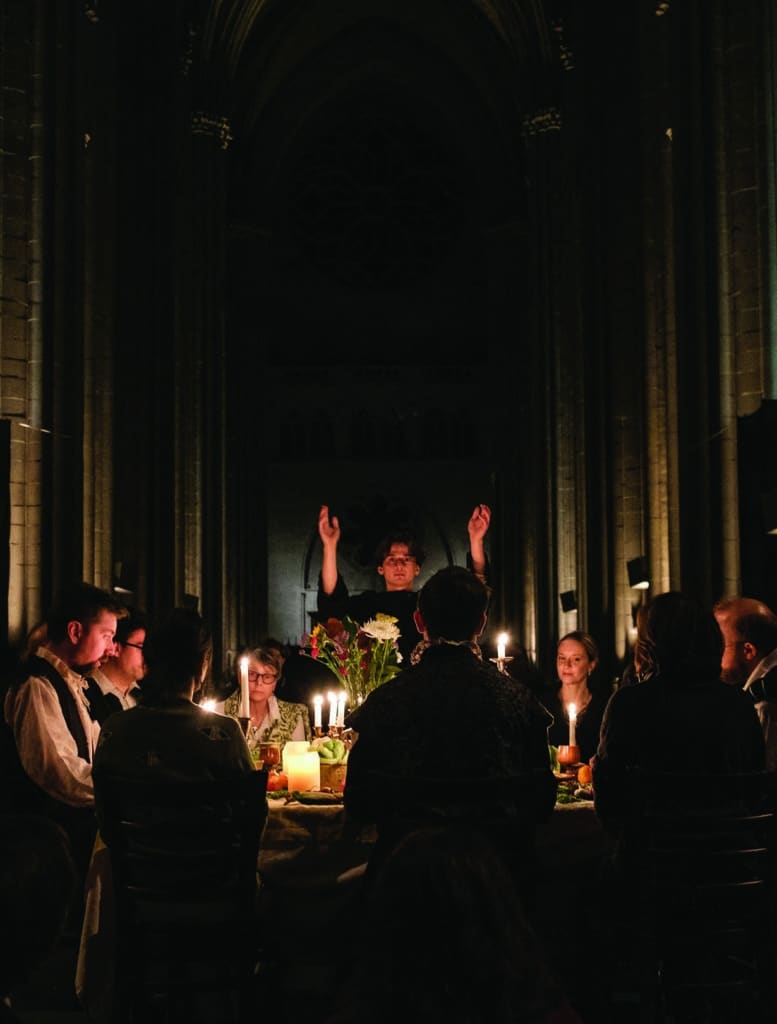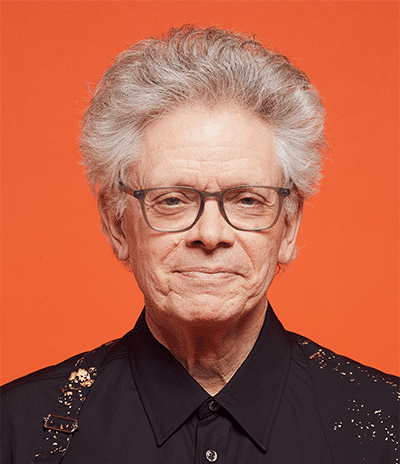The Growing Never Stops
In league with well-known, lesser-known, and even unknown composers, 20 years on, the JACK Quartet continues to expand and transform what and how we hear
The JACK Quartet. From left to right: Christopher Otto and Austin Wulliman, violins; Jay Campbell, cello; and John Pickford Richards, viola.

“If you’d told the young John Luther Adams that someday he’d be composing string quartets, he wouldn’t have laughed at you,” declared a 70-year- old John Luther Adams, now a celebrated composer, via email. “He would’ve snarled. But a couple of weeks ago, I completed my ninth string quartet.”
Why the about-face?
“It’s all because of the JACK Quartet,” Adams explained.
From the time their paths first crossed, when the JACK recorded two fledgling Adams quartet works, The Wind in High Places (2011) and Dream of the Canyon Wren (2013), something extraordinary transpired between the composer and his interpreters. Two previously disparate artistic journeys converged into a unanimous path, breaking new ground to reveal unanticipated destinations and detours. “Over the past decade, those extraordinary young men have become a kind of muse for me,” Adams said. “Composing for the JACK, I can follow the music wherever it wants to lead me, with the confidence that they will bring it into a sounding reality that exceeds my imagination.”
Adams is far from the only composer whose career has been touched by the JACK Quartet, whose members came together as students at the Eastman School of Music in 2005. Over the course of a career now entering its third decade, the JACK has earned uproarious ovations with performances of past masters like Xenakis and Carter, forged partnerships with iconic living creators ranging from Adams to John Zorn, and broken ground for dozens of freshly arrived contemporaries, including numerous creators who, like Adams, otherwise might never have ventured to write for string quartet.
Did any of the JACK players have a vision of what was to come? According to founding violinist Christopher Otto, no one was thinking so practically back then. “It was just really fun to play music that was exciting, like Lachenmann and Xenakis,” Otto recounted in a recent group interview at Columbia University’s Miller Theatre, the day before the quartet participated in a concert celebrating Zorn’s 70th birthday. “No one else was playing it, and we just really wanted to do it. It was only a few years later that we started to think, okay, what’s the long-term plan and the dream?” Violist and co-founder John Pickford Richards concurred. “It felt like an extension of school, in a way,” he said.
The following year, the four young players—including violinist Ari Streisfeld and cellist Kevin McFarland—adopted a name derived from the first initial of each member. By the time they relocated to New York City in 2007, something meaningful was brewing. The group’s ascent, rapid and prodigious, would encompass concerts that sparked critical acclaim and popular buzz, significant recordings, an ambitious tour schedule, and a slate of distinguished academic engagements and residencies.
This year, the JACK is marking its 20th anniversary. The now-eminent quartet—including violinist Austin Wulliman and cellist Jay Campbell, who replaced Streisfeld and McFarland in 2016—has plenty to celebrate. Due in spring are an authoritative collection of Zorn’s complete quartet works, and a recording of Adams’s Waves and Particles, the latest installment in an ongoing series documenting his quartets. Also planned for release later this year is Modern Medieval, based on a JACK-curated concert program that finds common threads among ancient and contemporary works. The group is mounting ambitious composer-themed excursions—Adams in Alaska, more Zorn in Europe, Georg Friedrich Haas in Germany—and returning to some of the world’s most prestigious venues, including London’s Wigmore Hall and Berlin’s Pierre Boulez Saal. JACK Studio, the ensemble’s namesake research and development initiative, begins its sixth year of facilitating and documenting new music by composers who might otherwise have been denied access to resources, not to mention the broad audience that JACK now commands.
Behind the group’s enthusiastic reception, even with the most difficult and rarefied works in its portfolio, is a compelling sense of mission that pervades its work. The quartet’s authority across the broadest imaginable range of sounds and idioms is unmistakable. The group’s playing admits paradox, showing rigor in Adams’s gentlest open-strings harmonics, and ease with Zorn’s most frenetic gesticulations. In everything the JACK does, its technique is assured, its advocacy for contemporary composers and works persuasive.
Those qualities have proved convincing to curators and presenters. “Their innate ability to count through any piece of music, sight-read expertly, and play with perfect intonation makes it so they can make an excellent reading of nearly anything put before them, which means they’re able to read more music than
any other string quartet,” said Aaron Greenwald, director of programming and engagement for the University of Iowa’s Hancher Auditorium. “By virtue of the above, they have a far better lens than most anyone else in the field to determine what’s compelling.” Another attraction, Greenwald says, is what he calls the group’s “very low pulse—meaning they don’t get overwhelmed by any performing situation . . . it is all okay,” he said. “While super intense, it seems that there’s rarely drama between the members.”
The JACK players confirm such chemistry. “We share a real passion for exploring certain aspects of contemporary music, and that makes it easy for us to be around each other, because we keep talking about and exploring the same stuff,” Wulliman said. “We like to talk about what we’re listening to; we like to talk about the ideas behind the music. So it becomes a very close-knit group of people who are all chasing these similar kinds of ideas, whether it’s stylistic stuff within the music or just the concept of collaboration and creativity in contemporary music.”
Just as vital to the JACK’s success, Otto points out, is striking a balance between personal interests and team goals. “It’s really important that we all have our individual things we care about and get excited about and bring to the group, and then see where the common points are,” he said. “Because there is so much overlap in all of our interests, I think we have a lot to work from.”
Adhering to the courage of your convictions is vital, as well. “Whenever I think about how few people listen to some of the stuff that we do, it can feel depressing,” Campbell confessed. The notion that music is somehow unworthy if it doesn’t appeal to a mass audience, he explains, can feel pervasive. “And that’s such a poisonous attitude to have about art,” he said. “It’s actually okay to be in a niche. It’s okay to be presenting music for a small amount of people who really do care about it.”
That steadfast advocacy has helped the JACK cultivate an audience that will follow the group wherever its explorations lead, including an openness to composers still in the process of establishing their voices and approaches. The group has enriched the canon substantially through the works it has commissioned, including potent pieces by Jason Eckardt (2010), Cenk Ergün (2014), and Catherine Lamb (2018). Lamb, whose music deals in minute gradations of pitch and extended duration, cites the group’s respectful approach to all composers, regardless of their technique or renown. “When I first started to work with them, I was surprised by how investigative each of them were, in their own way, into the material I was presenting them with,” she wrote in an email. “I quickly understood that this was not the typical ensemble to simply add a piece to their repertoire list, but actually seemed to take any opportunity presented to them as a potential for learning and a deepening of their already rich musical practices.”
A composer’s connection with JACK doesn’t cease after first contact, she added. “I am touched by the number of times they have played my music, always with great intensity, always striving to uncover something more each time,” she said. “The process continues, which to me is the most wonderful thing—the growing never stops.”
With JACK Studio, the group has broadened the canon further still by accommodating creators who might otherwise lack the resources provided by major universities and conservatories. “Not everybody can go to fancy schools,” Richards said, “so this was leaving out this huge population of people who don’t have access to us otherwise. In essence, we created our own kind of school residency.”
“It’s a way to kind of expand our network beyond the places that have the funding to pay us,” Otto added. “We’re basically self-producing most of this stuff, trying to see what’s out there and remove some of the barriers that exist.” Significantly, JACK Studio facilitates working with artists who aren’t conventionally trained as composers. “We had a lot of success with Elliot Reed, a choreographer who doesn’t read music but is very musical,” Campbell said. “He doesn’t need to know how to write music, or speak in a musical language that we understand through formal training; he can create a piece with us that exists outside of that. That’s kind of what we’re looking for.” The group’s aspiration, Wulliman says, is to program works emerging from JACK Studio alongside pieces by more established composers, in order to decouple an audience’s sense that recognition equals quality.
“We’re spending the time to try— and fumbling in the dark half the time— to find things that will get people to listen differently,” Wulliman said. “If there’s a vision for what JACK does, beyond just making music, it’s to get people to hear well.”



